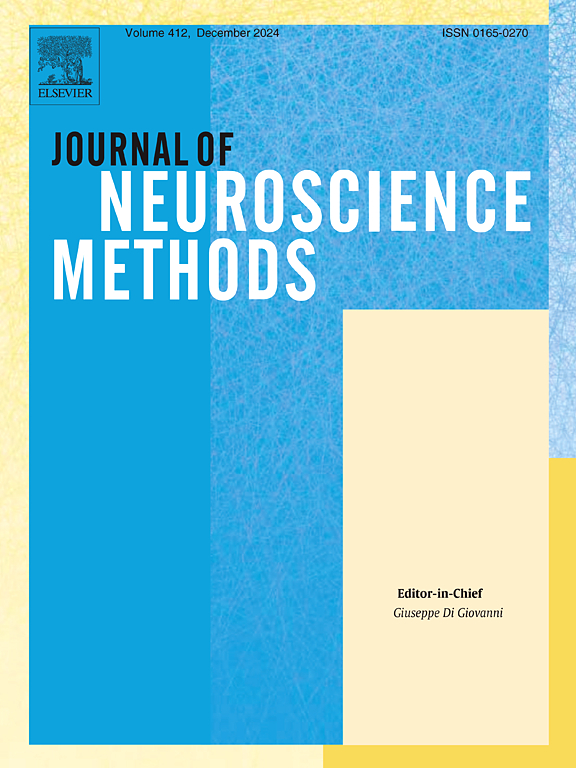Comparison of neural responses to whisker and ultrasound stimulation using a novel dual-stimulation protocol
IF 2.3
4区 医学
Q2 BIOCHEMICAL RESEARCH METHODS
引用次数: 0
Abstract
Background
The sensory system allows organisms to perceive and respond to environmental stimuli. This study investigates neural response differences between whisker and ultrasound stimulation in rats to evaluate cortical specificity to sensory inputs.
New method
A novel dual-stimulation protocol combining a step motor and ultrasound system was developed to alternately stimulate the C2 whisker and corresponding barrel column region. Experiments were conducted under varying stimulation sequences (whisker-ultrasound and ultrasound-whisker) and time intervals (10 ms, 25 ms, and 100 ms). Neural response signals were recorded, and statistical analyses (ANOVA and T-test) were performed to compare response amplitudes and peak latencies.
Results
Whisker stimulation consistently elicited significantly stronger neural responses than ultrasound stimulation (*p < 0.05), regardless of sequence or interval. The efficiency of neural responses to ultrasound was closely tied to frequency, with higher frequencies producing greater amplitudes and faster latencies. Notably, at a 25 ms interval in the ultrasound-whisker sequence, whisker responses were significantly enhanced compared to whisker stimulation alone, suggesting a pre-activation effect of ultrasound.
Comparison with existing methods
Unlike single-modal whisker or ultrasound stimulation, the dual-stimulation protocol can enhance sensory responses, highlighting its neuromodulatory potential.
Conclusion
This study reveals distinct cortical activation patterns induced by whisker and ultrasound stimulation. While whisker stimulation is more sensitive, ultrasound stimulation—when optimized for frequency and timing—can effectively modulate neural responses under dual-stimulation protocol. These findings provide insights into ultrasound-based neuromodulation and sensory processing.
用一种新的双刺激方案比较神经对须和超声刺激的反应
感觉系统使生物体能够感知环境刺激并作出反应。本研究探讨了超声刺激和触须刺激对大鼠神经反应的差异,以评估皮层对感觉输入的特异性。采用步进电机与超声系统相结合的新型双刺激方案,交替刺激C2晶须和相应的桶柱区域。实验在不同的刺激序列(须-超声和超声-须)和时间间隔(10 ms, 25 ms和100 ms)下进行。记录神经反应信号,并进行统计学分析(方差分析和t检验)比较反应幅度和峰值潜伏期。结果不论刺激顺序或时间间隔,须刺激均明显强于超声刺激(*p <; 0.05)。神经对超声波的反应效率与频率密切相关,频率越高,振幅越大,潜伏期越快。值得注意的是,在超声-须序列间隔25 ms时,与单独刺激须相比,须反应显著增强,这表明超声具有预激活作用。与现有方法相比,双刺激方案可以增强感觉反应,突出其神经调节潜力。结论本研究揭示了须和超声刺激诱导的不同皮层激活模式。虽然须刺激更敏感,但超声刺激-在优化频率和时间时-可以有效地调节双刺激方案下的神经反应。这些发现为基于超声波的神经调节和感觉处理提供了见解。
本文章由计算机程序翻译,如有差异,请以英文原文为准。
求助全文
约1分钟内获得全文
求助全文
来源期刊

Journal of Neuroscience Methods
医学-神经科学
CiteScore
7.10
自引率
3.30%
发文量
226
审稿时长
52 days
期刊介绍:
The Journal of Neuroscience Methods publishes papers that describe new methods that are specifically for neuroscience research conducted in invertebrates, vertebrates or in man. Major methodological improvements or important refinements of established neuroscience methods are also considered for publication. The Journal''s Scope includes all aspects of contemporary neuroscience research, including anatomical, behavioural, biochemical, cellular, computational, molecular, invasive and non-invasive imaging, optogenetic, and physiological research investigations.
 求助内容:
求助内容: 应助结果提醒方式:
应助结果提醒方式:


